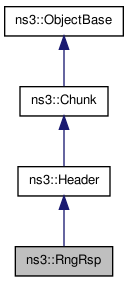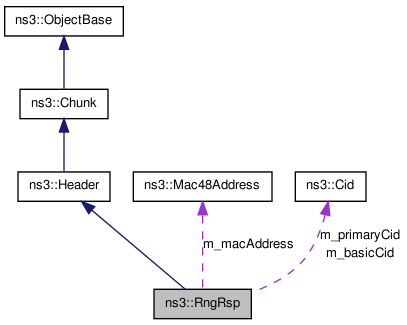

Public Member Functions | |
| RngRsp (void) | |
| This class implements the ranging response message described by "IEEE Standard for
Local and metropolitan area networks Part 16: Air Interface for Fixed Broadband Wireless Access Systems" 6.3.2.3.6 Ranging response (RNG-RSP) message, page 50. | |
| void | SetTimingAdjust (uint32_t timingAdjust) |
| set the Tx timing offset adjustment (signed 32-bit). | |
| void | SetPowerLevelAdjust (uint8_t powerLevelAdjust) |
| set the relative change in transmission power level that the SS should make in order that transmissions arrive at the BS at the desired power. When subchannelization is employed, the subscriber shall interpret the power offset adjustment as a required change to the transmitted power density. | |
| void | SetOffsetFreqAdjust (uint32_t offsetFreqAdjust) |
| set the relative change in transmission frequency that the SS should take in order to better match the BS. This is fine-frequency adjustment within a channel, not reassignment to a different channel | |
| void | SetRangStatus (uint8_t rangStatus) |
| void | SetDlFreqOverride (uint32_t dlFreqOverride) |
| set the Center frequency, in kHz, of new downlink channel where the SS should redo initial ranging. | |
| void | SetUlChnlIdOverride (uint8_t ulChnlIdOverride) |
| set the identifier of the uplink channel with which the SS is to redo initial ranging | |
| void | SetDlOperBurstProfile (uint16_t dlOperBurstProfile) |
| void | SetMacAddress (Mac48Address macAddress) |
| void | SetBasicCid (Cid basicCid) |
| void | SetPrimaryCid (Cid primaryCid) |
| void | SetAasBdcastPermission (uint8_t aasBdcastPermission) |
| void | SetFrameNumber (uint32_t frameNumber) |
| void | SetInitRangOppNumber (uint8_t initRangOppNumber) |
| void | SetRangSubchnl (uint8_t rangSubchnl) |
| uint32_t | GetTimingAdjust (void) const |
| uint8_t | GetPowerLevelAdjust (void) const |
| uint32_t | GetOffsetFreqAdjust (void) const |
| uint8_t | GetRangStatus (void) const |
| uint32_t | GetDlFreqOverride (void) const |
| uint8_t | GetUlChnlIdOverride (void) const |
| uint16_t | GetDlOperBurstProfile (void) const |
| Mac48Address | GetMacAddress (void) const |
| Cid | GetBasicCid (void) const |
| Cid | GetPrimaryCid (void) const |
| uint8_t | GetAasBdcastPermission (void) const |
| uint32_t | GetFrameNumber (void) const |
| uint8_t | GetInitRangOppNumber (void) const |
| uint8_t | GetRangSubchnl (void) const |
| std::string | GetName (void) const |
| virtual TypeId | GetInstanceTypeId (void) const |
| void | Print (std::ostream &os) const |
| uint32_t | GetSerializedSize (void) const |
| void | Serialize (Buffer::Iterator start) const |
| uint32_t | Deserialize (Buffer::Iterator start) |
Static Public Member Functions | |
| static TypeId | GetTypeId (void) |
| This method returns the TypeId associated to ns3::RngRsp. | |
Member Function Documentation
| uint32_t ns3::RngRsp::Deserialize | ( | Buffer::Iterator | start | ) | [virtual] |
- Parameters:
-
start an iterator which points to where the header should written.
- Returns:
- the number of bytes read.
This method is used by Packet::RemoveHeader to re-create a header from the byte buffer of a packet. The data read is expected to match bit-for-bit the representation of this header in real networks.
Implements ns3::Header.
| uint32_t ns3::RngRsp::GetDlFreqOverride | ( | void | ) | const |
- Returns:
- Center frequency, in kHz, of new downlink channel where the SS should redo initial ranging.
| uint16_t ns3::RngRsp::GetDlOperBurstProfile | ( | void | ) | const |
- Returns:
- DlOperBurstProfile: This parameter is sent in response to the RNG-REQ Requested Downlink Burst Profile parameter
| virtual TypeId ns3::RngRsp::GetInstanceTypeId | ( | void | ) | const [virtual] |
- Returns:
- the TypeId associated to the most-derived type of this instance.
This method is typically implemented by ns3::Object::GetInstanceTypeId but some classes which derive from ns3::ObjectBase directly have to implement it themselves.
Implements ns3::ObjectBase.
| uint32_t ns3::RngRsp::GetOffsetFreqAdjust | ( | void | ) | const |
- Returns:
- the relative change in transmission frequency that the SS should take in order to better match the BS. This is fine-frequency adjustment within a channel, not reassignment to a different channel.
| uint8_t ns3::RngRsp::GetPowerLevelAdjust | ( | void | ) | const |
- Returns:
- the relative change in transmission power level that the SS should take in order that transmissions arrive at the BS at the desired power. When subchannelization is employed, the subscriber shall interpret the power offset adjustment as a required change to the transmitted power density.
| uint32_t ns3::RngRsp::GetSerializedSize | ( | void | ) | const [virtual] |
- Returns:
- the expected size of the header.
This method is used by Packet::AddHeader to store a header into the byte buffer of a packet. This method should return the number of bytes which are needed to store the full header data by Serialize.
Implements ns3::Header.
| uint32_t ns3::RngRsp::GetTimingAdjust | ( | void | ) | const |
- Returns:
- Tx timing offset adjustment (signed 32-bit). The time required to advance SS transmission so frames arrive at the expected time instance at the BS.
| static TypeId ns3::RngRsp::GetTypeId | ( | void | ) | [static] |
This method returns the TypeId associated to ns3::RngRsp.
No Attributes defined for this type.
No TraceSources defined for this type.
Reimplemented from ns3::Header.
| uint8_t ns3::RngRsp::GetUlChnlIdOverride | ( | void | ) | const |
- Returns:
- The identifier of the uplink channel with which the SS is to redo initial ranging
| void ns3::RngRsp::Print | ( | std::ostream & | os | ) | const [virtual] |
- Parameters:
-
os output stream This method is used by Packet::Print to print the content of a trailer as ascii data to a c++ output stream. Although the trailer is free to format its output as it wishes, it is recommended to follow a few rules to integrate with the packet pretty printer: start with flags, small field values located between a pair of parens. Values should be separated by whitespace. Follow the parens with the important fields, separated by whitespace. i.e.: (field1 val1 field2 val2 field3 val3) field4 val4 field5 val5
Implements ns3::Header.
| void ns3::RngRsp::Serialize | ( | Buffer::Iterator | start | ) | const [virtual] |
- Parameters:
-
start an iterator which points to where the header should be written.
This method is used by Packet::AddHeader to store a header into the byte buffer of a packet. The data written is expected to match bit-for-bit the representation of this header in a real network.
Implements ns3::Header.
| void ns3::RngRsp::SetDlFreqOverride | ( | uint32_t | dlFreqOverride | ) |
set the Center frequency, in kHz, of new downlink channel where the SS should redo initial ranging.
- Parameters:
-
dlFreqOverride the Center frequency in kHz
| void ns3::RngRsp::SetOffsetFreqAdjust | ( | uint32_t | offsetFreqAdjust | ) |
set the relative change in transmission frequency that the SS should take in order to better match the BS. This is fine-frequency adjustment within a channel, not reassignment to a different channel
- Parameters:
-
offsetFreqAdjust
| void ns3::RngRsp::SetPowerLevelAdjust | ( | uint8_t | powerLevelAdjust | ) |
set the relative change in transmission power level that the SS should make in order that transmissions arrive at the BS at the desired power. When subchannelization is employed, the subscriber shall interpret the power offset adjustment as a required change to the transmitted power density.
- Parameters:
-
powerLevelAdjust the relative change in transmission power level
| void ns3::RngRsp::SetTimingAdjust | ( | uint32_t | timingAdjust | ) |
set the Tx timing offset adjustment (signed 32-bit).
- Parameters:
-
timingAdjust The time required to advance SS transmission so frames arrive at the expected time instance at the BS.
| void ns3::RngRsp::SetUlChnlIdOverride | ( | uint8_t | ulChnlIdOverride | ) |
set the identifier of the uplink channel with which the SS is to redo initial ranging
- Parameters:
-
ulChnlIdOverride the uplink channel index
The documentation for this class was generated from the following files:
- src/devices/wimax/mac-messages.h
- doc/introspected-doxygen.h
 1.7.1
1.7.1